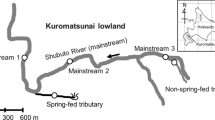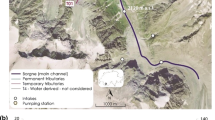Abstract
Fifty-two stream segments were sampled from 16 August to 13 September in 1993 in the eastern Atlantic Rainforest of São Paulo State, southeastern Brazil (22°55′–25°00′S, 44°48′–48°03′W). Forty-two macroalgal subgeneric taxa were found and the most widespread species were Audouinella pygmaea (21% of sites), Compsopogon leptoclados and Microcoleus subtorulosus (19%). Macroalgal species number per sampling site ranged from 0 to six (2.6 ± 1.7) and was positively correlated to species abundance, whereas species cover ranged from 0 to 70% of the stream bed (15.5 ± 20.8%). No significant correlation was found among macroalgal species number and abundance with any physical or chemical variable analyzed. Most sites were dominated by one or few macroalgal species, mainly, Audouinella macrospora, C. leptoclados and M. subtorulosus. No significant difference was found between the frequency distribution of variables measured for streams and for total macroalgae but the most widespread species (A. pygmaea) differed significantly for current velocity, specific conductance, turbidity and pH. Overall means for macroalgal occurrence include the following values: temperature (% MathType!MTEF!2!1!+-% feaafiart1ev1aaatCvAUfeBSjuyZL2yd9gzLbvyNv2CaerbuLwBLn% hiov2DGi1BTfMBaeXatLxBI9gBaerbd9wDYLwzYbItLDharqqtubsr% 4rNCHbGeaGqiVu0Je9sqqrpepC0xbbL8F4rqqrFfpeea0xe9Lq-Jc9% vqaqpepm0xbba9pwe9Q8fs0-yqaqpepae9pg0FirpepeKkFr0xfr-x% fr-xb9adbaqaaeGaciGaaiaabeqaamaabaabaaGcbaGaamiwaaaa!36CA!\[X\] = 19.9°C), current velocity (% MathType!MTEF!2!1!+-% feaafiart1ev1aaatCvAUfeBSjuyZL2yd9gzLbvyNv2CaerbuLwBLn% hiov2DGi1BTfMBaeXatLxBI9gBaerbd9wDYLwzYbItLDharqqtubsr% 4rNCHbGeaGqiVu0Je9sqqrpepC0xbbL8F4rqqrFfpeea0xe9Lq-Jc9% vqaqpepm0xbba9pwe9Q8fs0-yqaqpepae9pg0FirpepeKkFr0xfr-x% fr-xb9adbaqaaeGaciGaaiaabeqaamaabaabaaGcbaGaamiwaaaa!36CA!\[X\] = 45 cm s−1), oxygen saturation (% MathType!MTEF!2!1!+-% feaafiart1ev1aaatCvAUfeBSjuyZL2yd9gzLbvyNv2CaerbuLwBLn% hiov2DGi1BTfMBaeXatLxBI9gBaerbd9wDYLwzYbItLDharqqtubsr% 4rNCHbGeaGqiVu0Je9sqqrpepC0xbbL8F4rqqrFfpeea0xe9Lq-Jc9% vqaqpepm0xbba9pwe9Q8fs0-yqaqpepae9pg0FirpepeKkFr0xfr-x% fr-xb9adbaqaaeGaciGaaiaabeqaamaabaabaaGcbaGaamiwaaaa!36CA!\[X\] = 66%), specific conductance (% MathType!MTEF!2!1!+-% feaafiart1ev1aaatCvAUfeBSjuyZL2yd9gzLbvyNv2CaerbuLwBLn% hiov2DGi1BTfMBaeXatLxBI9gBaerbd9wDYLwzYbItLDharqqtubsr% 4rNCHbGeaGqiVu0Je9sqqrpepC0xbbL8F4rqqrFfpeea0xe9Lq-Jc9% vqaqpepm0xbba9pwe9Q8fs0-yqaqpepae9pg0FirpepeKkFr0xfr-x% fr-xb9adbaqaaeGaciGaaiaabeqaamaabaabaaGcbaGaamiwaaaa!36CA!\[X\] = 59.6 µS cm−1), turbidity (% MathType!MTEF!2!1!+-% feaafiart1ev1aaatCvAUfeBSjuyZL2yd9gzLbvyNv2CaerbuLwBLn% hiov2DGi1BTfMBaeXatLxBI9gBaerbd9wDYLwzYbItLDharqqtubsr% 4rNCHbGeaGqiVu0Je9sqqrpepC0xbbL8F4rqqrFfpeea0xe9Lq-Jc9% vqaqpepm0xbba9pwe9Q8fs0-yqaqpepae9pg0FirpepeKkFr0xfr-x% fr-xb9adbaqaaeGaciGaaiaabeqaamaabaabaaGcbaGaamiwaaaa!36CA!\[X\] = 5 NTU) and pH (% MathType!MTEF!2!1!+-% feaafiart1ev1aaatCvAUfeBSjuyZL2yd9gzLbvyNv2CaerbuLwBLn% hiov2DGi1BTfMBaeXatLxBI9gBaerbd9wDYLwzYbItLDharqqtubsr% 4rNCHbGeaGqiVu0Je9sqqrpepC0xbbL8F4rqqrFfpeea0xe9Lq-Jc9% vqaqpepm0xbba9pwe9Q8fs0-yqaqpepae9pg0FirpepeKkFr0xfr-x% fr-xb9adbaqaaeGaciGaaiaabeqaamaabaabaaGcbaGaamiwaaaa!36CA!\[X\] = 7.1). This pattern of patchy distribution and dominance by few species has been suggested as typical of stream macroalgal communities and has been ascribed to the rapid fluctuation of physical and chemical conditions. Total macroalgal species richness as well as mean species number per sampling site were considerably lower than found in similar studies of other regions. The Intermediate Disturbance Hypothesis was applied to explain these results: the same factor (high precipitation) responsible for the maintainance of the high species diversity in the surrounding forest can be, paradoxically, a constraint to the development of a more diverse macroalgal flora in streams.
Similar content being viewed by others
References
Anonymous, 1993. Atlas da evolução dos remanescentes florestais e ecossistemas associados do domínio da Mata Atlântica no período de 1985–1990: Estado de São Paulo. Fund. SOS Mata Atlântica & Inst. Nac. Pesq. Esp., São Paulo, 53 pp.
Biggs, B. J. F., 1990. Periphyton communities and their environments in New Zealand rivers. New Zealand J. mar. Freshwat. Res. 24: 367–386.
Biggs, B. J. F. & G. M. A. Price, 1987. A survey of filamentous algal proliferation in New Zealand rivers. New Zealand J. mar. Freshwat. Res. 21: 175–191.
Capobianco, J. P. R., 1992. Dossier Atlantic Rain Forest. Fund. SOS Mata Atlântica, São Paulo, 107 pp.
Connel, J. H., 1978. Diversity in tropical rain forest and coral reefs. Science 199: 1302–1309.
DeNicola, D. M., K. D. Hoagland & S. C. Roemer, 1992. Influences of canopy cover on spectral irradiance and periphyton assemblages in a prairie stream. J.N. Am. Benthol. Soc. 11: 391–404.
Digby, P. G. N. & R. A. Kempton, 1987. Multivariate analysis of ecological communities. Chapman and Hall, London, 206 pp.
Horner, R. R. & E. B. Welch, 1981. Stream periphyton development in relation to current velocity and nutrients. Can. J. Fish. Aquat. Sci. 38: 449–457.
Johansson, C., 1982. Attached algal vegetation in running water of Jämtland, Sweden. Acta phytogeogr. suec. 74: 1–84.
Krebs, C. J., 1989. Ecological methodology. Harper & Row, New York, 654 pp.
Melo, M. M. R. F. & W. Mantovani, 1994. Composição florística e estrutura de trecho de Mata Atlântica de encosta, na Ilha do Cardoso (Cananéia, SP, Brasil). Bol. Inst. bot. 9: 107–158.
Moulton, T. P., 1995. Ecologia dos rios e outros corpos de água na Ilha do Cardoso, São Paulo, Brasil. An. Simp. Ecossist. Cost. Bras. 3: in press.
Necchi, O. Jr., C. C. Z. Branco, R. C. G. Simão & L. H. Z. Branco, 1995. Distribution of stream macroalgae in the northwest region of São Paulo State, southeastern Brazil. Hydrobiologia 299: 219–230.
Necchi, O. Jr. & D. Pascoaloto, 1993. Seasonal dynamics of macroalgal communities in the Preto River basin, São Paulo, southeastern Brazil. Arch. Hydrobiol. 129: 231–252.
Sheath, R. G. & J. M. Burkholder, 1985. Characteristics of softwater streams in Rhode Island. II: Composition and seasonal dynamics of macroalgal communities. Hydrobiologia 128: 109–118.
Sheath, R. G. & K. M. Cole, 1992. Biogeography of stream macroalgae in North America. J. Phycol. 28: 448–460.
Sheath, R. G., P. B. Hamilton, J. A. Hambrook & K. M. Cole, 1989. Stream macroalgae of the eastern boreal forest region of North America. Can. J. Bot. 67: 3553–3562.
Sheath, R. G., M. O. Morison, J. E. Korch, D. Kaczmarczyk & K. M. Cole, 1986. Distribution of stream macroalgae in south-central Alaska. Hydrobiologia 135: 259–269.
Sokal, R. R. & F. J. Rohlf, 1981. Biometry. W. H. Freeman, New York, 859 pp.
Ward, J. V. & J. A. Stanford, 1983. The intermediate-disturbance hypothesis: an explanation for biotic diversity in lotic ecossistems. In T. D. Fontaine & S. M. Bartell (eds), Dynamics of lotic ecosystems. Ann Arbor Science Publ., Ann Arbor: 347–356.
Author information
Authors and Affiliations
Rights and permissions
About this article
Cite this article
Branco, C.C.Z., Necchi, O. Distribution of stream macroalgae in the eastern Atlantic Rainforest of São Paulo State, southeastern Brazil. Hydrobiologia 333, 139–150 (1996). https://doi.org/10.1007/BF00013428
Received:
Revised:
Accepted:
Issue Date:
DOI: https://doi.org/10.1007/BF00013428




